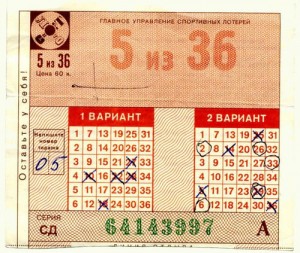Consider the following hypothetical lottery scheme. A player pays a dollar for a lottery ticket. On the ticket he has to mark a number between 1 and 100. When sufficient number of tickets was sold, the single "lucky number" is drawn randomly using a lotto machine, and half of the proceeds from ticket sales are shared equally among all tickets that bet on that number. The other half goes to charity.
Now, given the whole "charity" deal, the amount of money going into the lottery is greater than the amount of money paid back, hence the game is obviously disadvantageous for the players. The expected returns of an average ticket are just $0.5, hence "the house always wins", and "lottery is a tax on people who do not understand probability theory", as they say. Right? It turns out things are not that simple.
Suppose there are 100 000 people in the country who play this lottery, each one buying a single ticket. Let us imagine that, for some reason, everyone who plays the lottery is extremely superstitious and will never bet on the number 13 because it is universally despised as unlucky. Knowing that, let us now go and buy a single ticket, betting on 13. Behold: we have just paid one dollar for a 1% chance to win 50 000 dollars! Indeed, there is a 1% chance the lottery machine will draw 13 as the winning number and if this happens we will be the only candidate for receiving the whole winning fund - $50 000 in our case. Consequently, the expected returns for our ticket are $50 000 x 0.01 = $500, and the bet is well worth its price.
In general, it is easy to show that betting on any number which is sufficiently unpopular, namely any number which less than 500 of the 100 000 participants will decide to bet on, results in positive expected returns (note that on average we expect about 1000 people to bet on a "random" number).
To highlight the concept a bit more, let us consider an even better hypothetical possibility. Let us say that all of the 100 000 lottery players decide to bet on their birth dates. This means that their bets would cover only the numbers between 1 and 31. The smart idea then would be to buy 69 tickets, betting on each of the remaining numbers (32..100). Such a bet costs $69 and wins the sum of $50 034 with probability 69%. The expected returns per each dollar invested are still around $500, but in addition you win with astonishing certainty.
Does this have anything to do with reality? It turns out it does. This article from 1980 (in Russian) studies the popular Soviet lottery "Sportloto", in which the players had to select 5 or 6 numbers from a grid of 36 or 45 numbers respectively (see illustration above). The drawing was performed, and the players who managed to guess enough numbers would share a portion of the lottery fund. Note that this is just a more elaborate variation of the "pick one out of 100" lottery above. And of course, psychological aspects play a large role in biasing players' number selections. People tend to prefer numbers towards the bottom of the grid to those on the first lines. People prefer smaller numbers to larger ones. And, most importantly, people tend to avoid picking regular patterns (e.g. all numbers in a sequence, or those forming a nice rectangle), as such combinations intuitively seem to be "too improbable to happen".
This results in a situation where betting on a "psychologically improbable" pattern of numbers may turn out to be profitable in terms of expected returns. The authors of the mentioned article actually used historical lottery drawing data to estimate the returns they would have if they would constantly participate in Sportloto using such patterns, and reported the ratio of winnings to spending of around 1.15 to 1.39.
This is not meant to encourage you to gamble (moreover, most lotteries do not work this way), but if you have to, do not underestimate the luckiness of the unlucky numbers.






